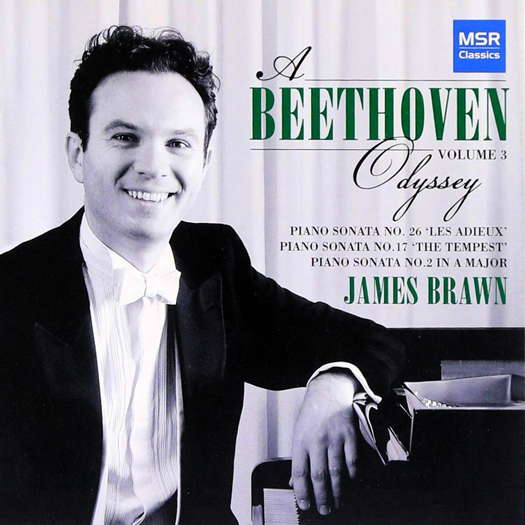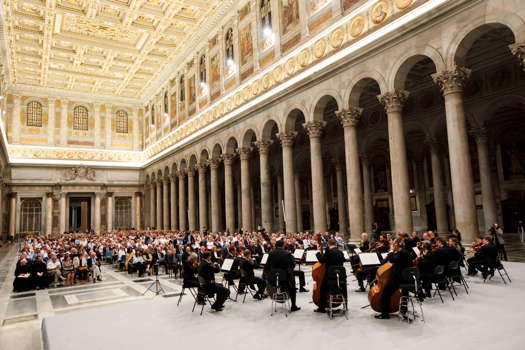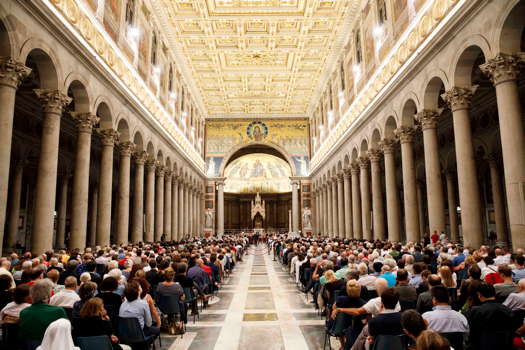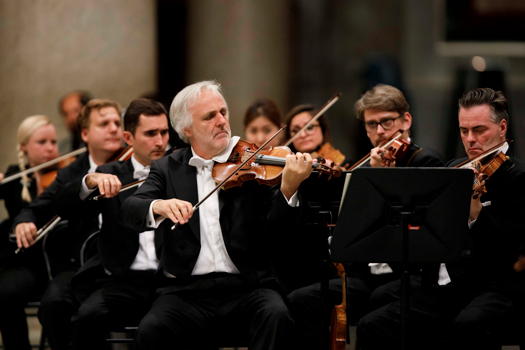- Lionel Sainsbury
- Dante Alighieri
- David Maslanka
- Laura Buruiana
- The Rise and Fall of the City of Mahagonny
- Presteigne
- The Fairy Queen
- Monica Ellis
 DISCUSSION: John Dante Prevedini leads a discussion about Composers, individuals or collective?, including contributions from David Arditti, Halida Dinova, Robert McCarney and Jane Stanley.
DISCUSSION: John Dante Prevedini leads a discussion about Composers, individuals or collective?, including contributions from David Arditti, Halida Dinova, Robert McCarney and Jane Stanley.
 SPONSORED: CD Spotlight. Masterful Handling - Volume 3 of James Brawn's Beethoven, praised by Andrew Schartmann.
SPONSORED: CD Spotlight. Masterful Handling - Volume 3 of James Brawn's Beethoven, praised by Andrew Schartmann.
All sponsored features >>
In the Vatican Basilicas
GIUSEPPE PENNISI reviews a special concert
For several years recently, I have reviewed concerts of a very special festival that has now reached its eighteenth edition. It is a festival of sacred music, sponsored by a private foundation - The Fondazione pro Musica ed Arte Sacra - which has a unique feature: the concerts are held in the Vatican Basilicas and important orchestras (such as the Wiener Philharmoniker and the IlluminArt Philharmonic Orchestra) are in residence. Entrance is free, but requires online registration.
This year, the festival was compacted into three days and five concerts. On 14 September 2019, in the morning, two concerts were held in St Peter's Basilicas. The first was a Spiritual Elevation on Mozart's music - the Coronation Mass KV 317 - as well as Giulio Caccini's Ave Maria performed by the IlluminArt Philharmonic Orchestra and Choir (from Japan). The second was a Holy Mass celebrated by H E Angelo Cardinal Comastri on the Missa de Angelis by Leo Kraemer (performed by the Orchestra and Chorus of Kazan State, the Palatina Klassik Vocal Ensemble and the Philharmonischer Chor an der Saar). In the evening, in St Paul Outside the Walls Basilica, the Wiener Philharmoniker performed Haydn's Die Sieben Letzten Worte Unseres Erlöser am Kreuze (The Seven Last Words of our Saviour on the Cross).
On Sunday 15 September 2019, Beethoven's Ninth Symphony was performed, again in St Paul Outside the Walls Basilica by IlluminArt Philharmonic Orchestra, soloists and chorus. On Monday 16 September in the Church of St Ignatius at Campus Martius, the Orchestra and chorus of Kazan, the Palatina Klassik Vocal Ensemble and the Philharmonischer Chor an der Saar played Beethoven's Mass in C major as well as Bruckner's Te Deum. The last concert on 17 September 2019 was a real treat: in St Mary Major Basilica, the Moscow Danilov Monastery Choir sang spiritual choral music from Russia.
From this compact and intense program, I selected Haydn's Die Sieben Letzten Worte Unseres Erlöser am Kreuze for two reasons: the subject has inspired various composers through the ages, and this was a rare occasion to listen to the first and original philological version of Haydn's work.

The performance of Haydn's The Seven Last Words of Our Saviour on the Cross at St Paul Outside the Walls Basilica on the evening of 14 September 2019. Photo © 2019 Musacchio, Ianniello & Pasqualini
Among others, Orlando di Lasso, Heinrich Schütz, Saverio Mercadante, Charles Gounod, César Franck, Théodore Dubois, Charles Tournemire, Lorenzo Perosi, Ruth Zechlin, Sofia Gubaidulina and James MacMillan have all composed works based on the Seven Last Words of Christ. The wording - the libretto, if you like - is taken from the Gospels of Mark, Luke and John. However, the composer's name we most associate with the text is Joseph Haydn, who not only wrote the most famous musical setting of the Seven Last Words, but wrote (or is responsible for) the four most famous versions.
The first is dated 1786. It was a commission by Cadiz Cathedral for a Good Friday celebration: an orchestral piece needing an ensemble of some thirty performers. Its debut was in the Cathedral, and before each of the movements (which Haydn called Sonatas), the Bishop read, in Latin, the line specifically related to each moment and, reportedly, added a commentary. In 1786, the Cathedral's recent renovation and expansion featured works by the greatest artists of the time, including paintings by Goya: adding music by the greatest contemporary composer only made sense. The music served almost as the stopgap between the pronouncement of the seven last words and lectures thereon. Even though it has attracted important conductors - for example there are three different recordings by Riccardo Muti with three prominent orchestras - this orchestral version is not as known as much as the later string quartet arrangement. Haydn also used the score for two other versions: a virtuoso fortepiano version and a choral version.
Haydn's challenge was to compose seven meditative instrumental movements. Seven adagios of just under ten minutes each in a row - eight, if you count the Maestoso ed Adagio introduction - could make for some very monotonous and turgid listening. Fortunately, Haydn was well aware of that and, more importantly, he was an unparalleled master of slow movements. He concluded the work with a short Presto e con tutta la Forza movement, representing the earthquake at the very moment of Jesus' death. The result was one of Haydn's proudest achievements (by his own estimation). He created a work that defies conventions and strikes one as modern yet old-fashioned at once - which is to say, timeless.

A view from the back of the audience at the Vienna Philharmonic Orchestra's performance of Haydn's The Seven Last Words of Our Saviour on the Cross. Photo © 2019 Musacchio, Ianniello & Pasqualini
In the huge but acoustically perfect St Paul Outside the Walls Basilica, the Weiner Philharmoniker rendered the composition beautifully. As in Haydn's times, there was no conductor, but Rainer Honeck - from a very musical family and a member of the orchestra since 1981 - was the concertmaster. Honeck and his colleagues were great in handling the slow movements with careful phrasing. Each setting of the text was read in Latin and other main modern languages, but it was expressed only by instrumental music in such a way that it created the most profound impression even on the most inexperienced listeners. Honeck had a light-touch conducting or rather mastering the ensemble and offered a smoothly luxuriant contribution.

Rainer Honeck leading the Vienna Philharmonic Orchestra in Haydn's The Seven Last Words of Our Saviour on the Cross. Photo © 2019 Musacchio, Ianniello & Pasqualini
The audience was enthusiastic.
Copyright © 18 September 2019
Giuseppe Pennisi,
Rome, Italy



